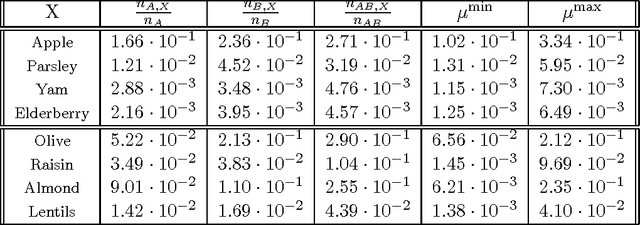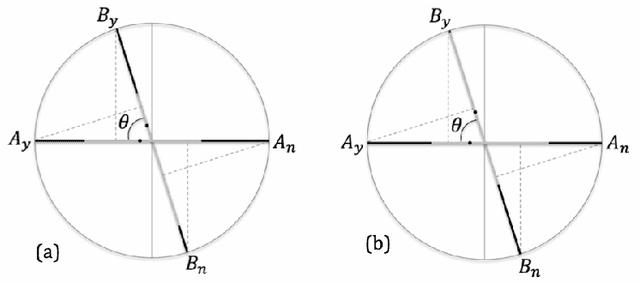Lyneth Beltran
Towards a Quantum World Wide Web
Jan 29, 2018
Abstract:We elaborate a quantum model for the meaning associated with corpora of written documents, like the pages forming the World Wide Web. To that end, we are guided by how physicists constructed quantum theory for microscopic entities, which unlike classical objects cannot be fully represented in our spatial theater. We suggest that a similar construction needs to be carried out by linguists and computational scientists, to capture the full meaning carried by collections of documental entities. More precisely, we show how to associate a quantum-like 'entity of meaning' to a 'language entity formed by printed documents', considering the latter as the collection of traces that are left by the former, in specific results of search actions that we describe as measurements. In other words, we offer a perspective where a collection of documents, like the Web, is described as the space of manifestation of a more complex entity - the QWeb - which is the object of our modeling, drawing its inspiration from previous studies on operational-realistic approaches to quantum physics and quantum modeling of human cognition and decision-making. We emphasize that a consistent QWeb model needs to account for the observed correlations between words appearing in printed documents, e.g., co-occurrences, as the latter would depend on the 'meaning connections' existing between the concepts that are associated with these words. In that respect, we show that both 'context and interference (quantum) effects' are required to explain the probabilities calculated by counting the relative number of documents containing certain words and co-ocurrrences of words.
Testing Quantum Models of Conjunction Fallacy on the World Wide Web
Jun 02, 2017Abstract:The 'conjunction fallacy' has been extensively debated by scholars in cognitive science and, in recent times, the discussion has been enriched by the proposal of modeling the fallacy using the quantum formalism. Two major quantum approaches have been put forward: the first assumes that respondents use a two-step sequential reasoning and that the fallacy results from the presence of 'question order effects'; the second assumes that respondents evaluate the cognitive situation as a whole and that the fallacy results from the 'emergence of new meanings', as an 'effect of overextension' in the conceptual conjunction. Thus, the question arises as to determine whether and to what extent conjunction fallacies would result from 'order effects' or, instead, from 'emergence effects'. To help clarify this situation, we propose to use the World Wide Web as an 'information space' that can be interrogated both in a sequential and non-sequential way, to test these two quantum approaches. We find that 'emergence effects', and not 'order effects', should be considered the main cognitive mechanism producing the observed conjunction fallacies.
Context and Interference Effects in the Combinations of Natural Concepts
Dec 19, 2016Abstract:The mathematical formalism of quantum theory exhibits significant effectiveness when applied to cognitive phenomena that have resisted traditional (set theoretical) modeling. Relying on a decade of research on the operational foundations of micro-physical and conceptual entities, we present a theoretical framework for the representation of concepts and their conjunctions and disjunctions that uses the quantum formalism. This framework provides a unified solution to the 'conceptual combinations problem' of cognitive psychology, explaining the observed deviations from classical (Boolean, fuzzy set and Kolmogorovian) structures in terms of genuine quantum effects. In particular, natural concepts 'interfere' when they combine to form more complex conceptual entities, and they also exhibit a 'quantum-type context-dependence', which are responsible of the 'over- and under-extension' that are systematically observed in experiments on membership judgments.
* 12 pages, no figures
Quantum cognition beyond Hilbert space II: Applications
Apr 27, 2016


Abstract:The research on human cognition has recently benefited from the use of the mathematical formalism of quantum theory in Hilbert space. However, cognitive situations exist which indicate that the Hilbert space structure, and the associated Born rule, would be insufficient to provide a satisfactory modeling of the collected data, so that one needs to go beyond Hilbert space. In Part I of this paper we follow this direction and present a general tension-reduction (GTR) model, in the ambit of an operational and realistic framework for human cognition. In this Part II we apply this non-Hilbertian quantum-like model to faithfully reproduce the probabilities of the 'Clinton/Gore' and 'Rose/Jackson' experiments on question order effects. We also explain why the GTR-model is needed if one wants to deal, in a fully consistent way, with response replicability and unpacking effects.
Quantum Cognition Beyond Hilbert Space I: Fundamentals
Apr 27, 2016


Abstract:The formalism of quantum theory in Hilbert space has been applied with success to the modeling and explanation of several cognitive phenomena, whereas traditional cognitive approaches were problematical. However, this 'quantum cognition paradigm' was recently challenged by its proven impossibility to simultaneously model 'question order effects' and 'response replicability'. In Part I of this paper we describe sequential dichotomic measurements within an operational and realistic framework for human cognition elaborated by ourselves, and represent them in a quantum-like 'extended Bloch representation' where the Born rule of quantum probability does not necessarily hold. In Part II we apply this mathematical framework to successfully model question order effects, response replicability and unpacking effects, thus opening the way toward quantum cognition beyond Hilbert space.
 Add to Chrome
Add to Chrome Add to Firefox
Add to Firefox Add to Edge
Add to Edge